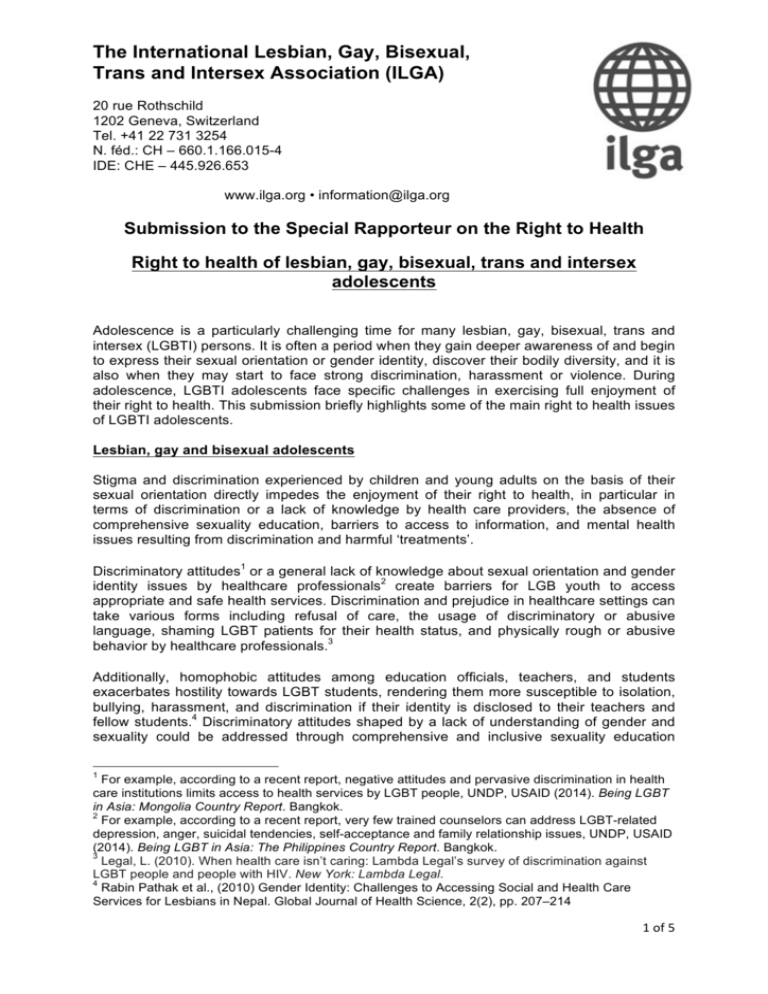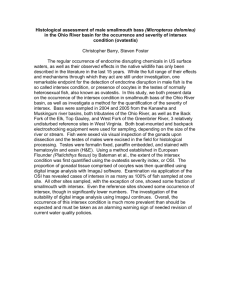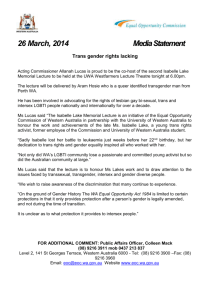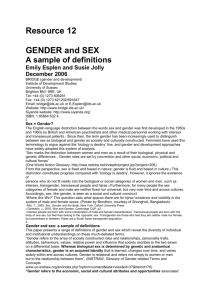
The International Lesbian, Gay, Bisexual,
Trans and Intersex Association (ILGA)
20 rue Rothschild
1202 Geneva, Switzerland
Tel. +41 22 731 3254
N. féd.: CH – 660.1.166.015-4
IDE: CHE – 445.926.653
www.ilga.org • information@ilga.org Submission to the Special Rapporteur on the Right to Health
Right to health of lesbian, gay, bisexual, trans and intersex
adolescents
Adolescence is a particularly challenging time for many lesbian, gay, bisexual, trans and
intersex (LGBTI) persons. It is often a period when they gain deeper awareness of and begin
to express their sexual orientation or gender identity, discover their bodily diversity, and it is
also when they may start to face strong discrimination, harassment or violence. During
adolescence, LGBTI adolescents face specific challenges in exercising full enjoyment of
their right to health. This submission briefly highlights some of the main right to health issues
of LGBTI adolescents.
Lesbian, gay and bisexual adolescents
Stigma and discrimination experienced by children and young adults on the basis of their
sexual orientation directly impedes the enjoyment of their right to health, in particular in
terms of discrimination or a lack of knowledge by health care providers, the absence of
comprehensive sexuality education, barriers to access to information, and mental health
issues resulting from discrimination and harmful ‘treatments’.
Discriminatory attitudes1 or a general lack of knowledge about sexual orientation and gender
identity issues by healthcare professionals2 create barriers for LGB youth to access
appropriate and safe health services. Discrimination and prejudice in healthcare settings can
take various forms including refusal of care, the usage of discriminatory or abusive
language, shaming LGBT patients for their health status, and physically rough or abusive
behavior by healthcare professionals.3
Additionally, homophobic attitudes among education officials, teachers, and students
exacerbates hostility towards LGBT students, rendering them more susceptible to isolation,
bullying, harassment, and discrimination if their identity is disclosed to their teachers and
fellow students.4 Discriminatory attitudes shaped by a lack of understanding of gender and
sexuality could be addressed through comprehensive and inclusive sexuality education
1
For example, according to a recent report, negative attitudes and pervasive discrimination in health
care institutions limits access to health services by LGBT people, UNDP, USAID (2014). Being LGBT
in Asia: Mongolia Country Report. Bangkok.
2
For example, according to a recent report, very few trained counselors can address LGBT-related
depression, anger, suicidal tendencies, self-acceptance and family relationship issues, UNDP, USAID
(2014). Being LGBT in Asia: The Philippines Country Report. Bangkok.
3
Legal, L. (2010). When health care isn’t caring: Lambda Legal’s survey of discrimination against
LGBT people and people with HIV. New York: Lambda Legal.
4
Rabin Pathak et al., (2010) Gender Identity: Challenges to Accessing Social and Health Care
Services for Lesbians in Nepal. Global Journal of Health Science, 2(2), pp. 207–214
1 of 5 programs. Unfortunately, sex education programs often do not adequately address the
specific needs of LGB students, further exacerbating discriminatory attitudes and making it
more difficult for these students to access accurate information about their sexual health.5
Moreover, negative portrayals of LGBT people in school textbooks that label homosexuals
as deviants, leads to an unsafe educational environment for LGB youth.6
In some countries, such as Russia, the dissemination of information about same sex
relationships among minors is illegal. Such legislation deprives LGB teenagers from
accessing information that is of vital importance for their physical and psychological integrity.
Lack of adequate information on sexual orientation and gender identity can lead to an
unhealthy and stressful adulthood for many LGBT people, especially among those who keep
their identity a secret.7
LGB children and adolescents experience higher rates of harassment, bullying, and physical
violence than their heterosexual peers. According to a 2012 UNESCO report, LGB youth are
likely to experience homophobic bullying in schools with less bullying at home or in the
community.8 In Canada, for example, a national survey found that 64% of all LGBTI students
reported feeling unsafe with schools, with 70% of participating students reporting having
heard homophobic comments every day in schools; 74% of trans students, 55% of sexual
minority students reported having been verbally harassed about their perceived sexual
orientation or gender expression; and more than one in five LGBT students reported being
physically harassed or assaulted due to their perceived sexual orientation or gender
identity.9 Homophobic bullying within schools has a negative impact on LGB teenagers in
terms of academic performance and school attendance. It can also lead to increased risk for
mental health problems, suicide, substance use, and high-risk sexual activity among LGB
adolescents.10
Another major risk to the mental health of LGB youth is the use of ‘reparative therapy’ and
sexual orientation ‘conversion therapy’. LGB adolescents are sometimes subjected to these
harmful ‘therapies’ intended to eliminate or suppress their same-sex sexual attraction.
According to the OHCHR, “such therapies have been found to be unethical, unscientific and
ineffective and, in some instances, tantamount to torture”11. Such ‘treatments’ are based
upon the false assumption that same sex attraction is a mental illness or disorder, further
fueling stigma, discrimination, and violence against lesbian, gay, and bisexual adolescents.
5
According to a recent report, current challenges faced by LGBT youth in China include a general
lack of education about sex and gender coupled with stigma towards LGBT people in sex education,
UNDP, USAID (2014). Being LGBT in Asia: China Country Report. Bangkok.
6
For example, according to a recent report, school textbooks in Thailand that label homosexuals as
deviants has lead to an unsafe educational environment for young LGBT persons, UNDP, USAID
(2014). Being LGBT in Asia: Thailand Country Report. Bangkok.
7
Institute of Medicine (US) Committee on Lesbian, Gay, Bisexual, and Transgender Health Issues
and Research Gaps and Opportunities, (2011)
8
UNESCO (2012). Good Policy and practice in HIV and health education: Education sector
responses to homophobic bullying. http://un- esdoc.unesco.org/images/0021/002164/216493e.pdf
9
Egale Human Rights Trust, Every class in every school: Final Report on the First National Climate
Survey on Homophobia, Biphobia, and Transphobia in Canadian Schools (2011), available at
http://egale.ca/every-class/
10
Birkett, M., Espelage, D. L., & Koenig, B. (2009). LGB and questioning students in schools: The
moderating effects of homophobic bullying and school climate on negative outcomes. Journal of
Youth and Adolescence, 38, 989-1000.
11
A/HRC/29/23
2 of 5 Trans adolescents
Trans and gender diverse adolescents are often viewed and treated discriminatorily by
schools, peers and the wider society and it is this lens which leads to barriers to health
services and increased health issues. Furthermore, trans adolescents face both transphobic
and homophobic discrimination, harassment and violence.
One survey in Australia reports a conflation of transphobia with homophobia in single sex
schools by teachers and peers – trans students were not allowed to wear uniforms that
reflected their gender identity, they faced homophobic violence from peers, and the teachers
policed the students fearing they sought to engage sexually with other students.12 Following
on from that, trans students who expressed frustration and anger had to attend ‘anger
management’ courses to have their behaviour and responses adjusted, rather than
addressing the sources of the homophobia and transphobia itself.13
Some participants of the same study pointed out that they often felt uncomfortable
approaching, or having to ‘come out’ to doctors and other health professionals, who were
often ill-informed about trans issues and were sometimes unsupportive and
homophobic/transphobic. The report also identified a need for increased training of doctors
and other health professionals in the sexual health needs of these young people.14
Technology is a tool used widely by adolescents who are questioning or exploring their
gender identities and expression – in this Australian survey 98% of the respondents had
internet access where they lived, with 85% using it to explore their sexual orientation and/or
gender identity. In addition, 24% used it to access social and support services which
included health services.15 Interestingly, most young people were aware of well-promoted,
established, and generic youth health services (often with a specialty in mental health) first,
before support services targeted at LGBT youth.16
It should be stated that it is not possible to predict the gender identity of a child with ‘gender
variant behaviour’, however some studies have found that compared to younger children,
gender dysphoria appears more likely to persist or present amongst adolescents, who then
are much more likely to medically transition than younger gender-nonconforming children.17
Some doctors are of the opinion that there are numerous psychological benefits to
suppressing puberty for trans adolescents. Most importantly, the reversible intervention can
prevent needless emotional and psychological suffering, which can be severe for some
adolescents (e.g., self-harming behaviours and suicidality).18
Harm reduction strategies are also important for adolescents in countries where they can
easily access over-the-counter hormones at low cost. This is the case in many countries in
Asia and trans adolescents in those situations therefore never consult doctors about long
12
Robinson, KH, Bansel, P, Denson, N, Ovenden, G & Davies, C 2014, Growing Up Queer: Issues
Facing Young Australians Who Are Gender Variant and Sexuality Diverse, Young and Well
Cooperative Research Centre, Melbourne, p(ix)
13
Ibid
14
Ibid
15
Ibid, p31
16
Ibid, p(x)
17
Health Policy Project, Asia Pacific Transgender Network, United Nations Development Programme.
2015, Blueprint for the Provision of Comprehensive Care for Trans People and Trans Communities,
Washington, DC: Futures Group, Health Policy Project, p97
18
Laura Edwards-Leeper and Norman P. Spack, “Psychological Evaluation and Medical Treatment of
Transgender Youth in an Interdisciplinary “Gender Management Service” in a Major Pediatric Center”,
Journal of Homosexuality, (2012) 59:3, 321-336, p.329
3 of 5 term hormone use, especially if those health professionals insist that they have to also
undergo psychotherapy associated with gender transition.19
Overall, interventions for adolescents should focus both on facilitating gender identity
development (irrespective of the nature of gender identity, i.e., boy, girl, third gender, or
gender-nonconforming) and the prevention of any problems in psychosocial adjustment that
involve the young person and their environment (e.g., family, friends, or others at school).20
Intersex adolescents
Adolescence is often when intersex children discover their bodily diversity. As puberty
progresses, intersex teenagers may encounter new health challenges as a result of
surgeries performed during their early childhood and/or due to the natural development of
their bodies. The obstacles faced by intersex teenagers in exercising their right to health will
be examined in the context of the adolescents’ personal situations, inadequacies of the
health services available, the need for mental health support, and the cross-cutting issue of
discrimination and prejudice.
The personal circumstances of intersex teenagers impacts heavily on their enjoyment of the
right to health, in particular their socio-economic situation and whether they live in urban or
rural settings. For example, in China, middle class families in urban areas are better placed
to access adequate medical information and health services.21 Intersex teenagers from
these families may have improved chances to access modern medical services and
treatment for any special health needs. Adolescents in rural areas, however, may not have
the same access to adequate health care, or to medical professionals with sufficient
knowledge of the health needs of intersex persons.
In addition, discrimination against intersex teenagers by their own families and communities
can also prevent them from accessing health care. Families may choose to hide their
children’s bodily diversity and health needs in order to save face and avoid stigmatisation by
the community.
A major obstacle to the enjoyment of the right to health of intersex adolescents is the lack of
knowledge among medical health professionals, even in high quality medical facilities. This
means that intersex adolescents and their families are not able to receive adequate
guidance or information regarding their health and healthcare needs. It is reported that
misdiagnoses and late diagnoses occur in smaller hospitals, in particular, and in some cases
medical professionals have claimed that there is no treatment available for some intersex
health issues that become apparent in adolescence.22
In addition to the lack of knowledge regarding intersex health issues, there are serious
concerns regarding the failure to respect the privacy of intersex adolescents, which makes
them and their families cautious of seeking medical assistance. As highlighted by a number
of intersex rights groups,23 this is problem is connected to the serious challenge of
pathologisation faced by intersex persons of all ages in terms of their treatment becoming a
medical case shared among health professionals without the full consent of the patient.
19
Blueprint for the Provision of Comprehensive Care for Trans People and Trans Communities, p100
Asia Pacific Trans Health Blueprint for the Provision of Comprehensive Care for Trans People and
Trans Communities, p99
21
According to information received from OII Chinese.
22
Ibid.
23
For example, OII Europe, Zwischengeschlecht.org and Advocates for Informed Choice.
20
4 of 5 Instead of decisions and surgeries being imposed on intersex children at a young age,
during adolescence, intersex children will be in the best position to make decisions regarding
their own bodies as they develop capacity and autonomy.24 As their bodies develop during
puberty, intersex children must be fully informed about their medical situation and needs, in
order to be able to make decisions about whether, for example, they would like to undergo a
gonadectomy or have genital surgery.
Mental health providers, in addition to playing a critical role in providing age-appropriate
information to intersex adolescents in order to assist them in making the decisions regarding
their bodies, are important actors in helping adolescents to combat the impact of
discrimination that intersex teenagers may face.25 Access to psychosocial support is
essential for intersex adolescents, who may suffer from secrecy, shame and isolation due to
the fact that their bodies do not fit male or female stereotypes as they pass through
puberty.26 Intersex teenagers may also discover that their gender identity does not coincide
with the gender that they were assigned during their early childhood. As a result, some may
face the same healthcare needs and barriers as trans adolescents.
In addition to physical development, as intersex adolescents begin to explore their sexuality
and to enter into relationships, it is essential that they receive adequate psychosocial
support.27 As one youth stated: “My peers were experimenting sexually while I was scared of
my own body . . . Surgery on my genitals wrecked my sense of self, my confidence as a
partner and a lover.”28 Feelings of inadequacy, unworthiness and shame can place intersex
adolescents at risk of sexual abuse.29
Mental health support for intersex teenagers must take into account the fact that the
personal circumstances and history of intersex children may vary widely. In addition, it is
crucial that families of intersex children receive adequate psychosocial support in order to be
able to assist intersex teenagers to maintain good mental health.30
24
Kohrman A, et al. Informed Consent, Parental Permission, and Assent in Pediatric Practice, 95
Pediatrics 314-17 (1995).
25
Malouf M and Baratz A, Disorders or Differences of Sex Development in Addressing the Needs of
Youth Who Are LGBT and Their Families: A System of Care Approach, Edited by Fisher SK, Ryan C,
Blau GM, 67-86 (2012).
26
According to information received from OII Chinese.
27
Malouf M and Baratz A.
28
Inter/Act, What We Wish Our Doctors Knew (2012), available at
https://aiclegal.files.wordpress.com/2012/10/interact_ms-updated.pdf
29
Malouf M and Baratz A.
30
Ibid.
5 of 5






